Geoheritage and Cultural Heritage—A Review of Recurrent and Interlinked Themes
Abstract
:1. Introduction
2. Geoheritage Sites of Additional Cultural Significance
3. Urban Geoheritage and Heritage Stones
4. Cultural Landscapes
5. Mining and Quarrying Heritage
6. Cultural Heritage Dimension of Natural Geophysical Disasters
7. Geoheritage and the History of Science
8. Geoheritage and Early Tourism
9. Geoheritage, Art and Literature
10. Geoheritage and Intangible Cultural Heritage
11. Geoheritage—Added Value at Cultural Heritage Sites
- The artificial caves of Elephanta off the Bombay coast in India, with numerous paintings and sculptures, excavated in multi-layered basaltic lava flows. A recent publication [217] drew attention to the paucity of geological information about the site and aimed to redress the balance.
- The archaeological area of Aksum in Ethiopia, known for the famous stelae, subterranean necropolises and ruined buildings. These historical monuments are integrated with the erosional scenery of exposed syenite plugs, with impressive rock cliffs, talus-covered slopes and boulder blankets (Figure 7a) [218].
- The rock island of Mont-Saint-Michel in Normandy, France [219], made famous by the Benedictine Abbey erected on the top, but being also a first-class example of rock-controlled relief amidst megatidal flats.
- The archaeological site of Petra in Jordan, with numerous elaborate structures dated to the turn of BC/AD times, half-built and half-carved into striking red sandstone outcrops. Geomorphology provides a magnificent setting to the ancient city, with high cliffs, rock platforms, extremely narrow gorges, and a variety of selective weathering features [221].
- The Thingvellir area in Iceland, inscribed in recognition of its cultural significance for the history of parliamentary culture, but at the same time being “perhaps the best place on this planet to understand the process of rupturing of the crust in response to the pulling forces of plate movements” [222]. The site contains superb examples of open fractures, trenches and grabens, waterfalls and lava outcrops (Figure 7c).
12. Systematic Approach versus Multiple Linkages
13. Conclusions
Author Contributions
Funding
Acknowledgments
Conflicts of Interest
References
- Brockx, M.; Semeniuk, V. Geoheritage and geoconservation—History, definition, scope and scale. J. R. Soc. West. Aust. 2007, 90, 53–87. [Google Scholar]
- Gordon, J.E. Geoheritage, geotourism and the cultural landscape: Enhancing the visitor experience and promoting geoconservation. Geosciences 2018, 8, 136. [Google Scholar] [CrossRef] [Green Version]
- Reynard, E.; Giusti, C. The landscape and the cultural value of geoheritage. In Geoheritage. Assessment, Protection, and Management; Reynard, E., Brilha, J., Eds.; Elsevier: Amsterdam, The Netherlands, 2018; pp. 147–166. [Google Scholar]
- Olson, K.; Dowling, R. Geotourism and cultural heritage. Geoconserv. Res. 2018, 1, 37–41. [Google Scholar] [CrossRef]
- Pásková, M.; Zelenka, J.; Ogasawara, T.; Zavala, B.; Astete, I. The ABC concept—Value added to the Earth heritage interpretation? Geoheritage 2021, 13, 38. [Google Scholar] [CrossRef]
- Reynard, E. Geomorphosites: Definitions and characteristics. In Geomorphosites; Reynard, E., Coratza, P., Regolini-Bissig, G., Eds.; Pfeil Verlag: Munich, Germany, 2009; pp. 9–20. [Google Scholar]
- Hobléa, F. Karstic geomorphosites: Managing subterranean natural-cultural heritage sites. In Geomorphosites; Reynard, E., Coratza, P., Regolini-Bissig, G., Eds.; Pfeil Verlag: Munich, Germany, 2009; pp. 189–200. [Google Scholar]
- Altunel, E.; D’Andria, F. Pamukkale travertines: A natural and cultural monument in the World Heritage List. In Landscapes and Landforms of Turkey; Kuzucuoğlu, C., Çiner, A., Kazancı, N., Eds.; Springer: Cham, Switzerland, 2019; pp. 219–229. [Google Scholar]
- Lazaridis, G. Caves in the conglomerates of the Meteora geosite (Greece). Cave Karst Sci. 2020, 47, 6–10. [Google Scholar]
- Rassios, A.E.; Ghikas, D.; Dilek, Y.; Vamvaka, A.; Batsi, A.; Koutsovitis, P. Meteora: A billion years of geological history in Greece to create a World Heritage Site. Geoheritage 2020, 12, 1–16. [Google Scholar] [CrossRef]
- Kiernan, K. Human impacts on geodiversity and associated natural values of bedrock hills in the Mekong Delta. Geoheritage 2010, 2, 101–122. [Google Scholar] [CrossRef]
- Kiernan, K. Impacts of war on geodiversity and geoheritage: Case studies of karst caves from northern Laos. Geoheritage 2012, 4, 225–247. [Google Scholar] [CrossRef]
- Sardella, R.; Iurino, D.A.; Mecozzi, B.; Sigari, D.; Bona, F.; Bellucci, L.; Coltorti, M.; Conti, J.; Lembo, G.; Muttillo, B.; et al. Grotta Romanelli (Lecce, Southern Italy) between past and future: New studies and perspectives for an archaeo-geosite symbol of the Palaeolithic in Europe. Geoheritage 2019, 11, 1413–1432. [Google Scholar] [CrossRef]
- Tronkov, D.; Sinnyovsky, D. Belogradchik Rocks, Bulgaria: Geological setting, genesis and geoconservation value. Geoheritage 2012, 4, 153–164. [Google Scholar] [CrossRef]
- Carreras, J.; Druguet, E.; Siddoway, C.S. Geological heritage beyond natural spaces: The Red Rocks Amphitheatre (Morrison, CO, USA), an example of syncretism between urban development and geoconservation. Geoheritage 2012, 4, 205–212. [Google Scholar] [CrossRef]
- Górska-Zabielska, M. The most valuable erratic boulders in the Wielkopolska region of western Poland and their potential to promote geotourism. Geo J. Tour. Geosites 2020, 13, 694–714. [Google Scholar] [CrossRef]
- Pukelytė, V.; Baltrūnas, V.; Karmaza, B. Geoheritage as a source and carrier of culture, Lithuania. Geoheritage 2022, 14, 8. [Google Scholar] [CrossRef]
- Migoń, P.; Michniewicz, A.; Różycka, M. Granite tors of the Waldviertel region in Lower Austria. In Landscapes and Landforms of Austria; Embleton-Hamann, C., Ed.; Springer: Cham, Switzerland, 2022. [Google Scholar]
- Costa, A.; Di Vito, M.A.; Ricciardi, G.P.; Smith, V.C.; Talamo, P. The long and intertwined record of humans and the Campi Flegrei volcano (Italy). Bull. Volcanol. 2022, 84, 5. [Google Scholar] [CrossRef]
- Megerle, H. Cultural values of geomorphosites within the Geopark Swabian Alb, Germany. Collect. EDYTEM 2013, 15, 149–154. [Google Scholar] [CrossRef]
- Megerle, H.E. Calcerous tufa as invaluable geotopes endangered by (over-)tourism: A case study in the UNESCO Global Geopark Swabian Alb, Germany. Geosciences 2021, 11, 198. [Google Scholar] [CrossRef]
- Thornbush, M.J.; Allen, C.D. (Eds.) Urban Geomorphology. Landforms and Processes in Cities; Elsevier: Amsterdam, The Netherlands, 2018. [Google Scholar]
- Reynard, E.; Pica, A.; Coratza, P. Urban geomorphological heritage. An Overview. Quaest. Geogr. 2017, 36, 7–20. [Google Scholar] [CrossRef] [Green Version]
- Vaz, T.; Zêzere, J.L. The urban geomorphological landscape of Lisbon. In Landscapes and Landforms of Portugal; Vieira, G., Zêzere, J.L., Mora, C., Eds.; Springer: Cham, Switzerland, 2020; pp. 295–303. [Google Scholar]
- Pelfini, M.; Brandolini, F.; D’Archi, S.; Pellegrini, L.; Bollati, I. Papia civitas gloriosa: Urban geomorphology for a thematic itinerary on geocultural heritage in Pavia (Central Po Plain, N Italy). J. Maps 2021, 17, 42–50. [Google Scholar] [CrossRef] [Green Version]
- Fernandes, N.F.; Tupinambá, M.; Mello, C.L.; Peixoto, M.N. Rio de Janeiro: A metropolis between granite-gneiss massifs. In Geomorphological Landscapes of the World; Migoń, P., Ed.; Springer: Dordrecht, The Netherlands, 2010; pp. 89–100. [Google Scholar]
- Silva, T.M.; Ferrari, A.L.; Tupinambá, M.; Fernandes, N. The Guanabara Bay, a giant body of water surrounded by mountains in the Rio de Janeiro metropolitan area. In Landscapes and Landforms of Brazil; Vieira, B.C., Salgado, A.A.R., Santos, L.J.C., Eds.; Springer: Dordrecht, The Netherlands, 2015; pp. 389–399. [Google Scholar]
- Pica, A.; Vergari, F.; Fredi, P.; Del Monte, M. The Aeterna Urbs geomorphological heritage (Rome, Italy). Geoheritage 2015, 8, 31–42. [Google Scholar] [CrossRef]
- Faccini, F.; Giardino, M.; Paliaga, G.; Perotti, L.; Brandolini, P. Urban geomorphology of Genoa old city (Italy). J. Maps 2021, 17, 51–64. [Google Scholar] [CrossRef]
- Pica, A.; Reynard, E.; Grangier, L.; Kaiser, C.; Ghiraldi, L.; Perotti, L.; Del Monte, M. GeoGuides, urban geotourism offer powered by mobile application technology. Geoheritage 2018, 10, 311–326. [Google Scholar] [CrossRef]
- Palacio-Prieto, J.L. Geoheritage within cities: Urban geosites in Mexico City. Geoheritage 2015, 7, 365–373. [Google Scholar] [CrossRef]
- Melelli, L. “Perugia Upside-Down”: A multimedia exhibition in Umbria (Central Italy) for improving geoheritage and geotourism in urban areas. Resources 2019, 8, 148. [Google Scholar] [CrossRef] [Green Version]
- Molewski, P. Anthropogenic degradation of dunes within a city: A disappearing feature of the cultural landscape of Toruń (Poland). J. Maps 2021, 17, 162–169. [Google Scholar] [CrossRef] [Green Version]
- Kubalíková, L.; Kirchner, K.; Kuda, F.; Bajer, A. Assessment of urban geotourism resources: An example of two geocultural sites in Brno, Czech Republic. Geoheritage 2020, 12, 7. [Google Scholar] [CrossRef]
- Németh, K.; Gravis, I.; Németh, B. Dilemma of geoconservation of monogenetic volcanic sites under fast urbanization and infrastructure developments with special relevance to the Auckland Volcanic Field, New Zealand. Sustainability 2021, 13, 6549. [Google Scholar] [CrossRef]
- Keller, B. Lake Lucerne and its spectacular landscape. In Landscapes and Landforms of Switzerland; Reynard, E., Ed.; Springer: Cham, Switzerland, 2021; pp. 305–323. [Google Scholar]
- Del Lama, E.A.; de la Corte Bacci, D.; Martins, L.; Motta Garcia, M.G.; Dehira, L.K. Urban geotourism and the old centre of São Paulo City, Brazil. Geoheritage 2015, 7, 147–164. [Google Scholar] [CrossRef]
- Da Silva, C.M. Urban geodiversity and decorative arts: The curious case of the “rudist tiles” of Lisbon (Portugal). Geoheritage 2019, 11, 151–163. [Google Scholar] [CrossRef]
- Pacheco, M.; Cachão, M. Urban geology of Lisbon: The importance of the National Palace of Ajuda (Lisbon, Portugal). Geoheritage 2021, 13, 84. [Google Scholar] [CrossRef]
- Zwoliński, Z.; Hildebrandt-Radke, I.; Mazurek, M.; Makohonienko, M. Existing and proposed urban geosites values resulting from geodiversity of Poznań City. Quaest. Geogr. 2017, 36, 125–149. [Google Scholar] [CrossRef] [Green Version]
- Vegas, J.; Díez-Herrero, A. An assessment method for urban geoheritage as a model for environmental awareness and geotourism (Segovia, Spain). Geoheritage 2021, 13, 27. [Google Scholar] [CrossRef]
- Erikstad, L.; Nakrem, H.A.; Markussen, J.A. Protected geosites in an urban area of Norway, inventories, values, and management. Geoheritage 2018, 10, 219–229. [Google Scholar] [CrossRef] [Green Version]
- Moradipour, F.; Moghimi, E.; Beglou, M.J.; Yamani, M. Assessment of urban geomorphological heritage for urban geotourism development in Khorramabad City, Iran. Geoheritage 2020, 12, 40. [Google Scholar] [CrossRef]
- Kubalíková, L. Cultural ecosystem services of geodiversity: A case study from Stránská skála (Brno, Czech Republic). Land 2020, 9, 105. [Google Scholar] [CrossRef] [Green Version]
- Tičar, J.; Komac, B.; Zorn, M.; Ferk, M.; Hrvatin, M.; Ciglič, R. From urban geodiversity to geoheritage: The case of Ljubljana (Slovenia). Quaest. Geogr. 2017, 36, 37–50. [Google Scholar] [CrossRef] [Green Version]
- Fio Firi, K.; Maričić, A. Usage of the natural stones in the City of Zagreb (Croatia) and its geotouristical aspect. Geoheritage 2020, 12, 62. [Google Scholar] [CrossRef]
- Górska-Zabielska, M.; Zabielski, R. Potential values of urban geotourism development in a small polish town (Pruszków, Central Mazovia, Poland). Quaest. Geogr. 2017, 36, 75–86. [Google Scholar] [CrossRef] [Green Version]
- Kubalíková, L.; Drápela, E.; Kirchner, K.; Bajer, A.; Balková, M.; Kuda, F. Urban geotourism development and geoconservation: Is it possible to find a balance? Environ. Sci. Policy 2021, 121, 1–10. [Google Scholar] [CrossRef]
- Borghi, A.; d’Atri, A.; Martire, L.; Castelli, D.; Costa, E.; Dino, G.; Favero-Longo, S.E.; Ferrando, S.; Gallo, L.M.; Giardino, M.; et al. Fragments of the Western Alpine Chain as historic ornamental stones in Turin (Italy): Enhancement of urban geological heritage through geotourism. Geoheritage 2014, 6, 41–55. [Google Scholar] [CrossRef]
- De Wever, P.; Baudin, F.; Pereira, D.; Cornée, A.; Egoroff, G.; Page, K. The importance of geosites and heritage stones in cities—A review. Geoheritage 2017, 9, 561–575. [Google Scholar] [CrossRef] [Green Version]
- Corbí, H.; Martínez-Martínez, J.; Martin-Rojas, I. Linking geological and architectural heritage in a singular geosite: Nueva Tabarca Island (SE Spain). Geoheritage 2019, 11, 703–716. [Google Scholar] [CrossRef]
- Freire-Lista, D.M.; Fort, R. Historical city centres and traditional building stones as heritage: Barrio de las Letras, Madrid (Spain). Geoheritage 2019, 11, 71–85. [Google Scholar] [CrossRef]
- Lezzerini, M.; Pagnotta, S.; Legnaioli, S.; Palleschi, V. Walking in the streets of Pisa to discover the stones used in the Middle Ages. Geoheritage 2019, 11, 1631–1641. [Google Scholar] [CrossRef]
- Pereira, D.; Perez-Castro, P. Art museums: A good context for outreach activities on natural stones and heritage. Geoheritage 2019, 11, 125–132. [Google Scholar] [CrossRef]
- Wolniewicz, P. Bringing the history of the Earth to the public by using storytelling and fossils from decorative stones of the city of Poznań, Poland. Geoheritage 2019, 11, 1827–1837. [Google Scholar] [CrossRef] [Green Version]
- Key, M.M.; Lieber, S.B.; Teagle, R.J. An historical geoarchaeological approach to sourcing an eighteenth century building stone: Use of Aquia Creek Sandstone in Christ Church, Lancaster County, VA, USA. Geoheritage 2020, 12, 4. [Google Scholar] [CrossRef]
- Dreesen, R.; Poty, E.; Mottequin, B.; Marion, J.-M.; Denayer, J. An exceptional Lower Carboniferous historical heritage stone from Belgium, the ‘Pierre de Meuse’. Geoheritage 2021, 13, 100. [Google Scholar] [CrossRef]
- Kubalíková, L.; Zapletalová, D. Geo-cultural aspects of building stone extracted within Brno City (Czech Republic): A bridge between natural and cultural heritage. Geoheritage 2021, 13, 78. [Google Scholar] [CrossRef]
- Santi, P.; Tramontana, M.; Tonelli, G.; Renzulli, A.; Veneri, F. The historic centre of Urbino, UNESCO World Heritage (Marche region, Italy): An urban-geological itinerary across the building and ornamental stones. Geoheritage 2021, 13, 86. [Google Scholar] [CrossRef]
- Woodcock, N.H.; Furness, E.N. Quantifying the history of building stone use in a heritage city: Cambridge, UK, 1040–2020. Geoheritage 2021, 13, 12. [Google Scholar] [CrossRef]
- Oyarzun, R.; Duque, J.F.M.; Barrenechea, J.F.; López García, J.A. Gossans, slates, and the red and black hamlets of Segovia (Spain): Interrelated geological and architectural features. Geoheritage 2018, 10, 109–121. [Google Scholar] [CrossRef]
- Kullberg, J.C.; Prego, A. The historical importance and architectonic relevance of the “extinct” Arrábida Breccia. Geoheritage 2019, 11, 87–111. [Google Scholar] [CrossRef]
- Damas Mollá, L.; Uriarte, J.A.; Zabaleta, A.; Aranburu, A.; García Garmilla, F.; Sagarna, M.; Bodego, A.; Clemente, J.A.; Morales, T.; Antigüedad, I. Red Ereño: An ornamental and construction limestone of international significance from the Basque country (northern Spain). Geoheritage 2021, 13, 2. [Google Scholar] [CrossRef]
- Cárdenes, V.; López-Piñeiro, S.; Ruiz de Argandoña, V.G. The relevance of the green phyllites of Lugo (Spain) in the architectonical heritage: An exceptional roofing slate resource. Geoheritage 2021, 13, 11. [Google Scholar] [CrossRef]
- Kaur, G.; Makki, M.F.; Avasia, R.K.; Bhusari, B.; Duraiswami, R.A.; Pandit, M.K.; Fareeduddin; Baskar, R.; Kad, S. The Late Cretaceous-Paleogene Deccan Traps: A potential global heritage stone province from India. Geoheritage 2019, 11, 973–989. [Google Scholar] [CrossRef]
- Garg, S.; Kaur, P.; Pandit, M.; Fareeduddin; Gurmeet, K.; Kamboj, A.; Thakur, S.N. Makrana marble: A popular heritage stone resource from NW India. Geoheritage 2019, 11, 909–925. [Google Scholar] [CrossRef]
- Garg, S.; Agarwal, P.; Ranawat, P.S.; Kaur, P.; Singh, A.; Saini, J.; Pandit, K.M.; Acharya, K.; Kaur, G. Rajnagar marble: A prominent heritage stone from Rajasthan, NW India. Geoheritage 2022, 14, 4. [Google Scholar] [CrossRef]
- Kaur, G.; Ahuja, A.; Thakur, S.N.; Pandit, M.; Duraiswami, R.; Singh, A.; Kaur, P.; Saini, J.; Goswami, R.G.; Prakash, J.; et al. Jodhpur Sandstone: An architectonic heritage stone from India. Geoheritage 2020, 12, 16. [Google Scholar] [CrossRef]
- Kaur, G.; Kaur, P.; Ahuja, A.; Singh, A.; Saini, J.; Agarwal, A.; Bhargava, O.N.; Pandit, M.; Giri, R.G.; Acharya, K.; et al. Jaisalmer golden limestone: A heritage stone resource from the desert of Western India. Geoheritage 2020, 12, 53. [Google Scholar] [CrossRef]
- Kaur, G.; Bhargava, O.N.; Ruiz de Argandoña, V.G.; Thakur, S.N.; Singh, A.; Saini, J.; Kaur, P.; Sharma, U.; Garg, U.; Singh, J.J.; et al. Proterozoic slates from Chamba and Kangra: A heritage stone resource from Himachal Pradesh, India. Geoheritage 2020, 12, 79. [Google Scholar] [CrossRef]
- Kaur, G.; Agarwal, P.; Garg, S.; Kaur, P.; Saini, J.; Singh, A.; Pandit, M.; Acharya, K.; Roopra, V.S.; Bhargava, O.N.; et al. The Alwar quartzite built architectural heritage of North India: A case for global heritage stone resource designation. Geoheritage 2021, 13, 55. [Google Scholar] [CrossRef]
- Bone, D.A. Historic building stones and their distribution in the churches and chapels of West Sussex, England. Proc. Geol. Assoc. 2016, 127, 53–77. [Google Scholar] [CrossRef]
- Ito, T.; Ichizawa, Y. Castellation incorporating geology and geography: Tenth–sixteenth century castles on chert of a Jurassic Accretionary Complex in Central Japan. Geoheritage 2022, 14, 17. [Google Scholar] [CrossRef]
- Szadkowska, K.; Szadkowski, M.; Tarka, R. Inventory and assessment of the geoheritage of the Sudetic Foreland Geopark (South-Western Poland). Geoheritage 2022, 14, 24. [Google Scholar] [CrossRef]
- Baucon, A.; Piazza, M.; Cabella, R.; Bonci, M.C.; Capponi, L.; Neto de Carvalho, C.; Briguglio, A. Buildings that ‘speak’: Ichnological geoheritage in 1930s buildings in Piazza della Vittoria (Genova, Italy). Geoheritage 2020, 12, 70. [Google Scholar] [CrossRef]
- Francischini, H.; Fernandes, M.A.; Kunzler, J.; Rodrigues, R.; Leonardi, G.; Carvalho, I.D.S. The ichnological record of Araraquara sidewalks: History, conservation, and perspectives from this urban paleontological heritage of southeastern Brazil. Geoheritage 2020, 12, 50. [Google Scholar] [CrossRef]
- Polck, M.A.d.R.; de Medeiros, M.A.M; de Araújo-Júnior, H.I. Geodiversity in urban cultural spaces of Rio de Janeiro city: Revealing the geoscientific knowledge with emphasis on the fossil content. Geoheritage 2020, 12, 47. [Google Scholar] [CrossRef]
- Simón-Porcar, G.; Martínez-Graña, A.; Simón, J.L.; González-Delgado, J.A.; Legoinha, P. Ordovician ichnofossils and popular architecture in Monsagro (Salamanca, Spain): Ethnopaleontology in the service of rural development. Geoheritage 2020, 12, 76. [Google Scholar] [CrossRef]
- Valentino, D.; Borghi, A.; d’Atri, A.; Gambino, F.; Martire, L.; Perotti, L.; Vaggelli, G. STONE Pietre Egizie: A free mobile application for promoting the scientific research on ornamental stones of Museo Egizio of Torino, Italy. Geoheritage 2020, 12, 61. [Google Scholar] [CrossRef]
- Richards, S.J.; Newsome, D.; Simpson, G. Architectural geoheritage, engaging the observer and the geotourism potential of the Lighthouse Hotel Rock Wall, Bunbury, Western Australia. Geoheritage 2020, 12, 75. [Google Scholar] [CrossRef]
- Del Lama, E.A. Potential for urban geotourism: Churches and cemeteries. Geoheritage 2019, 11, 717–728. [Google Scholar] [CrossRef]
- Pereira, L.S.; do Nascimento, M.A.L.; Mantesso-Neto, V. Geotouristic trail in the Senhor da Boa Sentença Cemetery, João Pessoa, State of Paraíba (PB), Northeastern Brazil. Geoheritage 2019, 11, 1133–1149. [Google Scholar] [CrossRef]
- Melelli, L.; Silvani, F.; Ercoli, M.; Pauselli, C.; Tosi, G.; Radicioni, F. Urban geology for the enhancement of the hypogean geosites: The Perugia underground (Central Italy). Geoheritage 2021, 13, 18. [Google Scholar] [CrossRef]
- Ramalho, E.C.; Marrero-Diaz, R.; Leitão, M.; Dias, R.; Ramada, A.; Pinto, C. Alfama springs, Lisbon, Portugal: Cultural geoheritage throughout the centuries. Geoheritage 2020, 12, 74. [Google Scholar] [CrossRef]
- Gordon, J.E. Rediscovering a sense of wonder: Geoheritage, geotourism and cultural landscape experiences. Geoheritage 2012, 4, 65–77. [Google Scholar] [CrossRef]
- Knight, J.; Harrison, S. A land history of men’: The intersection of geomorphology, culture and heritage in Cornwall, southwest England’. Appl. Geogr. 2013, 42, 186–194. [Google Scholar] [CrossRef]
- Wells, E.C. Cultural soilscapes. In Function of Soils for Human Societies and the Environment; Frossard, E., Blum, W.E.H., Warkentin, B.P., Eds.; Geological Society, Special Publications: London, UK, 2006; Volume 266, pp. 125–132. [Google Scholar]
- Szepesi, J.; Harangi, S.; Ésik, Z.; Novák, T.J.; Lukács, R.; Soós, I. Volcanic geoheritage and geotourism perspectives in Hungary: A case of an UNESCO World Heritage Site, Tokaj Wine Region Historic Cultural Landscape, Hungary. Geoheritage 2017, 9, 329–349. [Google Scholar] [CrossRef] [Green Version]
- Pijet-Migoń, E.; Migoń, P. Linking wine culture and geoheritage—Missing opportunities at European UNESCO World Heritage sites and in UNESCO Global Geoparks? A survey of web-based resources. Geoheritage 2021, 13, 71. [Google Scholar] [CrossRef]
- Reynard, E.; Estoppey, E. The Lavaux World Heritage terraced vineyard. In Landscapes and Landforms of Switzerland; Reynard, E., Ed.; Springer: Cham, Switzerland, 2021; pp. 111–122. [Google Scholar]
- Pereira, S. The terraced slopes of the Douro Valley. In Landscapes and Landforms of Portugal; Vieira, G., Zêzere, J.L., Mora, C., Eds.; Springer: Cham, Switzerland, 2020; pp. 151–162. [Google Scholar]
- Lugeri, F.R.; Amadio, V.; Bagnaia, R.; Cardilo, A.; Lugeri, N. Landscape and wine production areas: A geomorphological heritage. Geoheritage 2011, 3, 221–232. [Google Scholar] [CrossRef]
- Magliulo, P.; Di Lisio, A.; Sisto, M.; Valente, A. Geotouristic enhancement of high-quality wine production areas: Examples from Sannio and Irpinia landscapes (Campania Region, Southern Italy). Geoheritage 2020, 12, 18. [Google Scholar] [CrossRef]
- Meadows, M.E. The Cape Winelands. In Landscapes and Landforms of South Africa; Grab, S., Knight, J., Eds.; Springer: Cham, Switzerland, 2015; pp. 103–109. [Google Scholar]
- Amato, V.; Valletta, M. Wine landscapes of Italy. In Landscapes and Landforms of Italy; Soldati, M., Marchetti, M., Eds.; Springer: Cham, Switzerland, 2017; pp. 523–536. [Google Scholar]
- Collier, M. Field boundary stone walls as exemplars of “novel” ecosystems. Landsc. Res. 2013, 38, 141–150. [Google Scholar] [CrossRef] [Green Version]
- Duma, P.; Latocha, A.; Łuczak, A.; Piekalski, J. Stone walls as a characteristic feature of the cultural landscape of the Izera Mountains, southwestern Poland. Int. J. Hist. Archaeol. 2020, 24, 22–43. [Google Scholar] [CrossRef] [Green Version]
- Rosendahl, S.; Marçal Gonçalves, M. Joining geotourism with cultural tourism: A good blend. J. Tour. Herit. Res. 2019, 2, 252–275. [Google Scholar]
- Cyffka, B.; Bock, M. Degradation of field terraces in the Maltese Islands—Reasons, processes and effects. Geogr. Fis. Dinam. Quat. 2008, 31, 119–128. [Google Scholar]
- Tsermegas, I.; Dłużewski, M.; Biejat, K.; Szynkiewicz, A. Function of agricultural terraces in Mediterranean conditions—Selected examples from the island of Ikaria (the Southern Sporades, Greece). Misc. Geogr. 2011, 15, 65–78. [Google Scholar] [CrossRef]
- Migoń, P.; Latocha, A. Enhancement of cultural landscape by geomorphology. A study of granite parklands in the West Sudetes, SW Poland. Geogr. Fis. Dinam. Quat. 2008, 31, 195–203. [Google Scholar]
- Cárdenes, V.; Ponce de León, M.; Rodríguez, X.A.; Rubio-Ordoñez, A. Roofing slate industry in Spain: History, geology, and geoheritage. Geoheritage 2019, 11, 19–34. [Google Scholar] [CrossRef]
- Ballesteros, D.; Caldevilla, P.; Vila, R.; Barros, X.C.; Alemparte, M. Linking geoheritage and traditional architecture for mitigating depopulation in rural areas: The Palaeozoic Villages Route (Courel Mountains UNESCO Global Geopark, Spain). Geoheritage 2021, 13, 63. [Google Scholar] [CrossRef]
- Çiner, A.; Aydar, E. A fascinating gift from volcanoes: The Fairy Chimneys and underground cities of Cappadocia. In Landscapes and Landforms of Turkey; Kuzucuoğlu, C., Çiner, A., Kazancı, N., Eds.; Springer: Cham, Switzerland, 2019; pp. 535–549. [Google Scholar]
- Adamovič, J.; Mikuláš, R.; Cílek, V. Atlas Pískovcových Skalnych Měst České a Slovenské Republiky: Geologie a Geomorfologie; Academia: Prague, Czech Republic, 2010. [Google Scholar]
- Bruno, D.E.; Perrotta, P. A geotouristic proposal for Amendolara territory (northern Ionic sector of Calabria, Italy). Geoheritage 2012, 4, 139–151. [Google Scholar] [CrossRef]
- Bentivenga, M.; Capece, A.; Guglielmi, P.; Martorano, S.; Napoleone, D.; Palladino, G.; De Luca, V. The San Giorgio Lucano anthropic cave complex (Basilicata, Southern Italy): A geosite to protect and enhance. Geoheritage 2019, 11, 1509–1519. [Google Scholar] [CrossRef]
- Boukhchim, N.; Fraj, T.B.; Reynard, E. Lateral and “vertico-lateral” cave dwellings in Haddej and Guermessa: Characteristic geocultural heritage of southeast Tunisia. Geoheritage 2018, 10, 575–590. [Google Scholar] [CrossRef]
- Gamkrelidze, I.; Okrostsvaridze, A.; Koiava, K.; Maisadze, F. Potential Geoparks of Georgia. In Geotourism Potential of Georgia, the Caucasus; Springer: Cham, Switzerland, 2021; pp. 57–81. [Google Scholar] [CrossRef]
- Coratza, P.; Gauci, R.; Schembri; Soldati, M.; Tonelli, C. Bridging natural and cultural values of sites with outstanding scenery: Evidence from Gozo, Maltese Islands. Geoheritage 2016, 8, 91–103. [Google Scholar] [CrossRef]
- Gauci, R.; Schembri, J.A.; Inkpen, R. Traditional use of shore platforms: A study of the artisanal management of salinas on the Maltese Islands (Central Mediterranean). SAGE Open 2017, 7, 1–16. [Google Scholar] [CrossRef] [Green Version]
- Gauci, R.; Inkpen, R. The physical characteristics of limestone shore platforms on the Maltese Islands and their neglected contribution to coastal land use development. In Landscapes and Landforms of Malta; Gauci, R., Schembri, J.A., Eds.; Springer: Cham, Switzerland, 2019; pp. 343–356. [Google Scholar]
- Iranzo-García, E.; Kortekaas, K.H.; López, E.R. Inland salinas in Spain: Classification, characterisation, and reflections on unique cultural landscapes and geoheritage. Geoheritage 2021, 13, 24. [Google Scholar] [CrossRef]
- Schembri, J.A.; Spiteri, S.C. By gentlemen for gentlemen—Ria coastal landforms and the fortified imprints of Valletta and its harbours. In Landscapes and Landforms of Malta; Gauci, R., Schembri, J.A., Eds.; Springer: Cham, Switzerland, 2019; pp. 69–78. [Google Scholar]
- Burt, T.; Tucker, M. The geomorphology of the Whin Sill. In Landscapes and Landforms of England and Wales; Goudie, A., Migoń, P., Eds.; Springer: Cham, Switzerland, 2020; pp. 515–530. [Google Scholar]
- Kausch, B.; Maquil, R. Landscapes and landforms of the Luxembourg Sandstone, Grand-Duchy of Luxembourg. In Landscapes and Landforms of Belgium and Luxembourg; Demoulin, A., Ed.; Springer: Cham, Switzerland, 2018; pp. 43–62. [Google Scholar]
- Ren, F. The interplay between Taoist philosophy, Danxia Landscape and human beings—‘Tao follows nature’. In Sandstone Landscapes. Diversity, Ecology and Conservation, Proceedings of the 3rd International Conference on Sandstone Landscapes, Kudowa-Zdrój, Poland, 25–28 April 2012; Migoń, P., Kasprzak, M., Eds.; Department of Geography and Regional Development, University of Wrocław: Wrocław, Poland, 2013; pp. 159–162. [Google Scholar]
- Kiernan, K. Landforms as sacred places: Implications for geodiversity and geoheritage. Geoheritage 2015, 7, 177–193. [Google Scholar] [CrossRef]
- López-García, J.A.; Oyarzun, R.; López Andrés, S.; Manteca Martínez, J.I. Scientific, educational, and environmental considerations regarding mine sites and geoheritage: A perspective from SE Spain. Geoheritage 2011, 3, 267–275. [Google Scholar] [CrossRef] [Green Version]
- Mateos, R.M.; Durán, J.J.; Robledo, P.A. Marès quarries on the Majorcan coast (Spain) as geological heritage sites. Geoheritage 2011, 3, 41–54. [Google Scholar] [CrossRef]
- Todaro, S. The potential geosite of the “Libeccio Antico” quarries: A sedimentological and stratigraphic characterisation of ornamental stone from Mt Cocuccio, Custonaci Marble District, Sicily. Geoheritage 2019, 11, 809–820. [Google Scholar] [CrossRef]
- Gioncada, A.; Pitzalis, E.; Cioni, R.; Fulignati, P.; Lezzerini, M.; Mundula, F.; Funedda, A. The volcanic and mining geoheritage of San Pietro Island (Sulcis, Sardinia, Italy): The potential for geosite valorization. Geoheritage 2019, 11, 1567–1581. [Google Scholar] [CrossRef]
- Ruban, D.A.; Sallam, E.S.; Khater, T.M.; Ermolaev, V.A. Golden Triangle geosites: Preliminary geoheritage assessment in a geologically rich area of eastern Egypt. Geoheritage 2021, 13, 54. [Google Scholar] [CrossRef]
- Beretić, N.; Đukanović, Z.; Cecchini, A. Geotourism as a development tool of the Geo-mining Park in Sardinia. Geoheritage 2019, 11, 1689–1704. [Google Scholar] [CrossRef]
- Costa, E.; Dino, G.A.; Benna, P.; Rossetti, P. The Traversella mining site as Piemonte geosite. Geoheritage 2019, 11, 55–70. [Google Scholar] [CrossRef]
- Matías, R.; Llamas, B. Analysis using LIDAR and photointerpretation of Las Murias-Los Tallares (Castrocontrigo, León-Spain): One of the biggest Roman gold mines to use the “Peines” system. Geoheritage 2019, 11, 381–397. [Google Scholar] [CrossRef]
- Pérez-Aguilar, A.; Juliani, C.; de Barros, E.J.; Magalhães de Andrade, M.R.; de Oliveira, E.S.; Braga, D.d.A.; Santos, R.O. Archaeological gold mining structures from colonial period present in Guarulhos and Mairiporã, São Paulo State, Brazil. Geoheritage 2013, 5, 87–105. [Google Scholar] [CrossRef]
- Abdel-Maksoud, K.M.; Emam, M.A. Hidden geology in Ancient Egypt. Geoheritage 2019, 11, 897–907. [Google Scholar] [CrossRef]
- Lorenc, M.W.; Cocks, A. Inscribing a landscape: The Cornish Mining World Heritage Site. Geoturystyka 2008, 1, 27–40. [Google Scholar]
- Peréz Sánchez, A.A.; Lorenc, M.W. The cultural landscape of the Linares-La Carolina mining district (Spain). Geoturystyka 2008, 3, 13–26. [Google Scholar] [CrossRef]
- Lenart, J. The Nízký Jeseník—Highland with abandoned deep mines. In Landscapes and Landforms of the Czech Republic; Pánek, T., Hradecký, J., Eds.; Springer: Cham, Switzerland, 2016; pp. 305–317. [Google Scholar]
- Gallala, W.; Younes, A.; Ouazaa, N.L.; Hadjzobir, S. Roman millstones of Carthage (Tunisia): A geoarchaeological study using petrological and geochemical methods. Geoheritage 2018, 10, 673–686. [Google Scholar] [CrossRef]
- Careddu, N.; Grillo, S.M. Sardinian basalt—An ancient georesource still en vogue. Geoheritage 2019, 11, 35–45. [Google Scholar] [CrossRef]
- Careddu, N.; Grillo, S.M. “Trachytes” from Sardinia: Geoheritage and current use. Sustainability 2019, 11, 3706. [Google Scholar] [CrossRef] [Green Version]
- Lapuente Mercadal, M.P.; Cuchí Oterino, J.A.; Blanc, P.; Brilli, M. Louvie-Soubiron marble: Heritage stone in the French Pyrenean Ossau Valley—first evidence of the Roman Trans-Pyrenean use. Geoheritage 2021, 13, 17. [Google Scholar] [CrossRef]
- Stefano, M.; Paolo, S. Abandoned quarries and geotourism: An opportunity for the Salento Quarry District (Apulia, Southern Italy). Geoheritage 2017, 9, 463–477. [Google Scholar] [CrossRef]
- Baczyńska, E.; Lorenc, M.W.; Kaźmierczak, U. The landscape attractiveness of abandoned quarries. Geoheritage 2018, 10, 271–285. [Google Scholar] [CrossRef] [Green Version]
- AlRayyan, K.; Hamarneh, C.; Sukkar, H.; Ghaith, A.; Abu-Jaber, N. From abandoned mines to a labyrinth of knowledge: A conceptual design for a geoheritage park museum in Jordan. Geoheritage 2019, 11, 257–270. [Google Scholar] [CrossRef]
- Gajek, G.; Zgłobicki, W.; Kołodyńska-Gawrysiak, R. Geoeducational value of quarries located within the Małopolska Vistula River Gap (E Poland). Geoheritage 2019, 11, 1335–1351. [Google Scholar] [CrossRef] [Green Version]
- Kazancı, N.; Suludere, Y.; Özgüneylioğlu, A.; Mülazımoğlu, N.S.; Şaroğlu, F.; Mengi, H.; Boyraz-Aslan, S.; Gürbüz, E.; Onur Yücel, T.; Ersöz, M.; et al. Mining heritage and relevant geosites as possible instruments for sustainable development of miner towns in Turkey. Geoheritage 2019, 11, 1267–1276. [Google Scholar] [CrossRef]
- Marengo, A.; Borghi, A.; Bittarello, E.; Costa, E. Touristic fruition of the disused quarry of Busca Onyx: Problematics and strategies. Geoheritage 2019, 11, 47–54. [Google Scholar] [CrossRef]
- Brzezińska-Wójcik, T.; Skowronek, E. Tangible heritage of the historical stonework centre in Brusno Stare in the Roztocze Area (SE Poland) as an opportunity for the development of geotourism. Geoheritage 2020, 12, 10. [Google Scholar] [CrossRef] [Green Version]
- Martínez, A.M.D.; Timarán, F.P. Evaluation of candidate sites in a proposal for sustainable development: “The Gold Route”, Nariño, Colombia. Geoheritage 2020, 12, 56. [Google Scholar] [CrossRef]
- Ruiz Pulpón, Á.R.; Cañizares Ruiz, M.C. Enhancing the territorial heritage of declining rural areas in Spain: Towards integrating top-down and bottom-up approaches. Land 2020, 9, 216. [Google Scholar] [CrossRef]
- Milu, V. Preliminary assessment of the geological and mining heritage of the Golden Quadrilateral (Metaliferi Mountains, Romania) as a potential geotourism destination. Sustainability 2021, 13, 10114. [Google Scholar] [CrossRef]
- Reyes, C.A.R.; Amorocho-Parra, R.; Villarreal-Jaimes, C.A.; Meza-Ortíz, J.A.; Castellanos-Alarcón, O.M.; Madero-Pinzon, H.D.; Casadiego-Quintero, E.; Carvajal-Díaz, J.D. Geotourism in regions with influence from the oil industry: A study case of the Middle Magdalena Valley Basin (Colombia). Geoheritage 2021, 13, 107. [Google Scholar] [CrossRef]
- Hellqvist, M. Teaching sustainability in geoscience field education at Falun Mine World Heritage Site in Sweden. Geoheritage 2019, 11, 1785–1798. [Google Scholar] [CrossRef] [Green Version]
- Cavalcanti, J.A.D.; da Silva, M.S.; Schobbenhaus, C.; de Mota Lima, H. Geo-mining heritages of the Mariana Anticline Region, southeast of Quadrilátero Ferrífero-MG, Brazil: Qualitative and quantitative assessment of Chico Rei and Passagem mines. Geoheritage 2021, 13, 98. [Google Scholar] [CrossRef]
- Rybár, P.; Hronček, P. Mining tourism and the search for its origins. Geotourism/Geoturystyka 2017, 50–51, 27–66. [Google Scholar] [CrossRef]
- Wrede, V.; Mügge-Bartolović, V. GeoRoute Ruhr—A network of geotrails in the Ruhr Area National GeoPark, Germany. Geoheritage 2012, 4, 109–114. [Google Scholar] [CrossRef]
- Farsani, N.T.; Esfahani, M.A.G.; Shokrizadeh, M. Understanding tourists’ satisfaction and motivation regarding mining geotours (case study: Isfahan, Iran). Geoheritage 2019, 11, 681–688. [Google Scholar] [CrossRef]
- Prosser, C.D. Geoconservation, quarrying and mining: Opportunities and challenges illustrated through working in partnership with the mineral extraction industry in England. Geoheritage 2018, 10, 259–270. [Google Scholar] [CrossRef]
- Radwański, A.B. The oil and ozokerite mine in Boryslav and historical monuments of petroleum and salt industries in its vicinity (Fore-Carpathian region, Ukraine). Geoturystyka 2009, 3, 35–44. [Google Scholar]
- Radwański, A.B. The Ignacy Łukasiewicz Memorial Museum of Oil and Gas Industry in Bóbrka and historical monuments of petroleum and salt industries in the vicinity of Krosno (the Polish Outer Carpathians). Geoturystyka 2009, 3, 35–44. [Google Scholar] [CrossRef]
- Briševac, Z.; Maričić, A.; Brkić, V. Croatian geoheritage sites with the best-case study analyses regarding former mining and petroleum activities. Geoheritage 2021, 13, 95. [Google Scholar] [CrossRef]
- Roy, N.; Pandey, B.W.; Rani, U. Protecting the vanishing geo-cultural heritage of India: Case study of Majuli Island in Assam. Int. J. Geoheritage Parks 2020, 8, 18–30. [Google Scholar] [CrossRef]
- Tosatti, G. Slope instability affecting the Canossa geosite (Northern Apennines, Italy). Geogr. Fis. Dinam. Quat. 2008, 31, 239–246. [Google Scholar]
- Margottini, C.; Di Buduo, G. The geological and landslides museum of Civita di Bagnoregio (Central Italy). Landslides 2017, 14, 435–445. [Google Scholar] [CrossRef]
- Gutiérrez, F.; Cooper, A.H. Evaporite dissolution subsidence in the historical city of Calatayud, Spain: Damage appraisal and prevention. Nat. Haz. 2002, 25, 259–288. [Google Scholar] [CrossRef]
- Łabuz, T. Morfodynamika i tempo erozji klifu w Trzęsaczu (1997–2017). Landf. Anal. 2017, 34, 29–50. [Google Scholar] [CrossRef]
- Munzar, J.; Deutsch, M.; Elleder, L.; Ondracek, S.; Kallabova, E.; Hradek, M. Historical floods in Central Europe and their documentation by means of floodmarks and other epigraphical monuments. Morav. Geogr. Rep. 2006, 14, 26–44. [Google Scholar]
- Herget, J. Am Anfang war die Sintflut. In Hochwasserkatastrophen in der Geschichte; WBG: Darmstadt, Germany, 2012. [Google Scholar]
- Pekárová, P.; Halmová, D.; Bačová Mitková, V.; Miklánek, P.; Pekár, J.; Škoda, P. Historic flood marks and flood frequency analysis of the Danube River at Bratislava, Slovakia. J. Hydrol. Hydromech. 2013, 61, 326–333. [Google Scholar] [CrossRef] [Green Version]
- Coratza, P.; De Waele, J. Geomorphosites and natural hazards: Teaching the importance of geomorphology in society. Geoheritage 2012, 4, 195–203. [Google Scholar] [CrossRef]
- Migoń, P.; Pijet-Migoń, E. Natural disasters, geotourism and geo-education. Geoheritage 2019, 11, 629–640. [Google Scholar] [CrossRef] [Green Version]
- Wallace, A. Presenting Pompeii: Steps towards reconciling conservation and tourism at an ancient site. Pap. Inst. Archeol. 2012, 22, 115–136. [Google Scholar]
- Scandone, R.; Giacomelli, L. Vesuvius, Pompei, Herculaneum: A lesson in natural history. J. Res. Didact. Geogr. 2014, 2, 33–41. [Google Scholar]
- Gorokhovich, Y. Santorini, Eruption. In Encyclopedia of Natural Hazards, Bobrowsky, P., Ed.; Springer: Dordrecht, The Netherlands, 2013; pp. 884–895. [Google Scholar]
- Hancock, P.L.; Chalmers, R.M.L.; Altunel, E.; Çakir, Z.; Becher-Hancock, A. Creation and destruction of travertine monumental stone by earthquake faulting at Hierapolis, Turkey. Geol. Soc. Lond. Spec. Publ. 2000, 171, 1–14. [Google Scholar] [CrossRef]
- Silva, P.G.; Borja, F.; Zazo, C.; Goy, J.L.; Bardajı, T.; De Luque, L.; Lario, J.; Dabrio, C.J. Archaeoseismic record at the ancient Roman City of Baelo Claudia (Cádiz, south Spain). Tectonophysics 2005, 408, 129–146. [Google Scholar] [CrossRef] [Green Version]
- Guidoboni, E.; Muggia, A.; Marconi, C.; Boschi, E. A case study in archaeoseismology. The collapses of the Selinunte temples (southwestern Sicily): Two earthquakes identified. Bull. Seismol. Soc. Amer. 2002, 92, 2961–2982. [Google Scholar] [CrossRef]
- Alcantara-Ayala, I. Parícutin volcano: To the other side. In Geomorphological Landscapes of the World; Migoń, P., Ed.; Springer: Dordrecht, The Netherlands, 2010; pp. 59–68. [Google Scholar]
- Gizzi, F.T.; Bentivenga, M.; Lasaponara, R.; Danese, M.; Potenza, M.R.; Sileo, M.; Masini, N. Natural hazards, human factors, and “ghost towns”: A multi-level approach. Geoheritage 2019, 11, 1533–1565. [Google Scholar] [CrossRef]
- Migoń, P. Rediscovering geoheritage, reinventing geotourism—200 years of experience from the Sudetes, Central Europe. In Appreciating Physical Landscapes; Special Publications; Hose, T.A., Ed.; Geological Society: London, UK, 2016; Volume 417, pp. 215–228. [Google Scholar]
- Hose, T.A. Geological inquiry in Britain and England: A brief history. In Geoheritage and Geotourism. A European Perspective; Hose, T.A., Ed.; Boydell Press: Woodbridge, UK, 2016; pp. 31–53. [Google Scholar]
- Munt, M.C. Geoheritage case study: The Isle of Wight, England. In Geoheritage and Geotourism. A European Perspective; Hose, T.A., Ed.; Boydell Press: Woodbridge, UK, 2016; pp. 195–204. [Google Scholar]
- Hose, T.A. Museums and geoheritage in Britain and England. In Geoheritage and Geotourism. A European Perspective; Hose, T.A., Ed.; Boydell Press: Woodbridge, UK, 2016; pp. 55–79. [Google Scholar]
- De Wever, P.; Guiraud, M. Geoheritage and museums. In Geoheritage. Assessment, Protection, and Management; Reynard, E., Brilha, J., Eds.; Elsevier: Amsterdam, The Netherlands, 2018; pp. 129–145. [Google Scholar]
- Borghi, A.; Vignetta, E.; Ghignone, S.; Gallo, M.; Vaggelli, G. The “Stella Polare” expedition (1899–1900): Study and enhancement of the rock collection. Geoheritage 2020, 12, 33. [Google Scholar] [CrossRef]
- De Lima, J.T.M.; de Souza Carvalho, I. Geological or cultural heritage? The ex situ scientific collections as a remnant of nature and culture. Geoheritage 2020, 12, 3. [Google Scholar] [CrossRef]
- Vicedo, V.; Ozkaya de Juanas, S.; Fernández-Lluch, D.; Batlles, A.; Ballester, M. Enhancing the educational value of palaeontological heritage: The didactic collection of the Museu de Ciències Naturals de Barcelona (Catalonia, Spain) and its strategic framework. Geoheritage 2021, 13, 19. [Google Scholar] [CrossRef]
- Rapprich, V.; Valenta, J.; Brož, M.; Kadlecová, E.; van Wyk de Vries, B.; Petronis, M.; Rojík, P. A crucial site in the argument between Neptunists and Plutonists: Reopening of the historical adit in the Komorní hůrka (Kammerbühl) volcano after 180 years. Geoheritage 2019, 11, 347–358. [Google Scholar] [CrossRef]
- Reynard, E. Geoheritage case study: Canton Valais, Switzerland. In Geoheritage and Geotourism. A European Perspective; Hose, T.A., Ed.; Boydell Press: Woodbridge, UK, 2016; pp. 279–290. [Google Scholar]
- Aucelli, P.P.C.; Brancaccio, L.; Cinque, A. Vesuvius and Campi Flegrei: Volcanic history, landforms and impact on settlements. In Landscapes and Landforms of Italy; Soldati, M., Marchetti, M., Eds.; Springer: Cham, Switzerland, 2017; pp. 389–398. [Google Scholar]
- Coratza, P.; Panizza, M. Goethe’s Italian journey and the geological landscape. In Landscapes and Landforms of Italy; Soldati, M., Marchetti, M., Eds.; Springer: Cham, Switzerland, 2017; pp. 511–521. [Google Scholar]
- Hose, T.A. Geotourism in Britain and Europe: Historical and modern perspectives. In Geoheritage and Geotourism. A European Perspective; Hose, T.A., Ed.; Boydell Press: Woodbridge, UK, 2016; pp. 153–172. [Google Scholar]
- Hose, T.A. Towards a history of geotourism: Definitions, antecedents and the future. In The History of Geoconservation; Special Publications; Burek, C.V., Prosser, C.D., Eds.; Geological Society: London, UK, 2008; Volume 300, pp. 37–60. [Google Scholar]
- Gordon, J.E.; Baker, M. Appreciating geology and the physical landscape in Scotland: From tourism of awe to experiential re-engagement. In Appreciating Physical Landscapes; Special Publications; Hose, T.A., Ed.; Geological Society: London, UK, 2016; Volume 417, pp. 25–40. [Google Scholar]
- Hose, T.A. Geoheritage in the field. In Geoheritage and Geotourism. A European Perspective; Hose, T.A., Ed.; Boydell Press: Woodbridge, UK, 2016; pp. 101–127. [Google Scholar]
- Gordon, J.E. Geotourism and cultural heritage. In Handbook of Geotourism; Dowling, R., Newsome, D., Eds.; Edward Elgar: Cheltenham, UK, 2018; pp. 61–75. [Google Scholar]
- Chylińska, D. The role of the picturesque in geotourism and iconic geotourist landscapes. Geoheritage 2019, 11, 531–543. [Google Scholar] [CrossRef] [Green Version]
- Motte, E.; McInnes, R. Using artistic imagery to improve understanding of coastal landscape. Changes on the Rance Estuary (French Channel Coast). Geoheritage 2019, 11, 961–972. [Google Scholar] [CrossRef]
- Conly, G. Tarawera. The Destruction of the Pink and White Terraces; Grantham House: Wellington, New Zealand, 1985. [Google Scholar]
- Zumbühl, H.J.; Nussbaumer, S.U.; Wipf, A. Top of Europe: The Finsteraarhorn—Jungfrau glacier landscape. In Landscapes and Landforms of Switzerland; Reynard, E., Ed.; Springer: Cham, Switzerland, 2021; pp. 217–233. [Google Scholar]
- Pullin, R. The artist as geotourist: Eugene von Guérard and the seminal sites of early volcanic research in Europe and Australia. In Appreciating Physical Landscapes; Special Publications; Hose, T.A., Ed.; Geological Society: London, UK, 2016; Volume 417, pp. 59–70. [Google Scholar]
- Moore, R. The Isle of Wight Undercliff. In Landscapes and Landforms of England and Wales; Goudie, A., Migoń, P., Eds.; Springer: Cham, Switzerland, 2020; pp. 145–167. [Google Scholar]
- Sabato, L.; Tropeano, M.; Festa, V.; Longhitano, S.G.; dell’Olio, M. Following writings and paintings by Carlo Levi to promote geology within the “Matera-Basilicata 2019, European Capital of Culture” events (Matera, Grassano, Aliano—Southern Italy). Geoheritage 2019, 11, 329–346. [Google Scholar] [CrossRef]
- Nesci, O.; Borchia, R. Landscapes and landforms of the Duchy of Urbino in Italian renaissance paintings. In Landscapes and Landforms of Italy; Soldati, M., Marchetti, M., Eds.; Springer: Cham, Switzerland, 2017; pp. 257–269. [Google Scholar]
- Da Silva, C.M. Geodiversity and sense of place: Local identity geological elements in Portuguese municipal heraldry. Geoheritage 2019, 11, 949–960. [Google Scholar] [CrossRef]
- González-Delgado, J.Á.; Martínez-Graña, A.; Holgado, M.; Gonzalo, J.C.; Legoinha, P. Augmented reality as a tool for promoting the tourist value of the geological heritage around natural filming locations: A case study in “Sad Hill” (The Good, the Bad and the Ugly Movie, Burgos, Spain). Geoheritage 2020, 12, 34. [Google Scholar] [CrossRef]
- Vitaliano, D. Geomythology: Geological origins of myths and legends. In Myth and Geology; Special Publications; Piccardi, L., Masse, W.B., Eds.; Geological Society: London, UK, 2007; Volume 273, pp. 1–7. [Google Scholar]
- Trifonov, V.G. The Bible and geology: Destruction of Sodom and Gomorrah. In Myth and Geology; Special Publications; Piccardi, L., Masse, W.B., Eds.; Geological Society: London, UK, 2007; Volume 273. [Google Scholar]
- Piccardi, L. The AD 60 Denizli Basin earthquake and the apparition of Archangel Michael at Colossae (Aegean Turkey). In Myth and Geology; Special Publications; Piccardi, L., Masse, W.B., Eds.; Geological Society: London, UK, 2007; Volume 273, pp. 95–105. [Google Scholar]
- Mörner, N.-A. The Fenris Wolf in the Nordic Asa creed in the light of palaeoseismics. In Myth and Geology; Special Publications; Piccardi, L., Masse, W.B., Eds.; Geological Society: London, UK, 2007; Volume 273, pp. 143–163. [Google Scholar]
- Nunn, P.D.; Pastorizo, M.R. Geological histories and geohazard potential of Pacific Islands illuminated by myths. In Myth and Geology; Special Publications; Piccardi, L., Masse, W.B., Eds.; Geological Society: London, UK, 2007; Volume 273, pp. 117–119. [Google Scholar]
- Bryant, E.; Walsh, G.; Abbott, D. Cosmogenic mega-tsunami in the Australia region: Are they supported by Aboriginal and Maori legends. In Myth and Geology; Special Publications; Piccardi, L., Masse, W.B., Eds.; Geological Society: London, UK, 2007; Volume 273, pp. 203–214. [Google Scholar]
- Berger, W.H. On the discovery of the ice age: Science and myth. In Myth and Geology; Special Publications; Piccardi, L., Masse, W.B., Eds.; Geological Society: London, UK, 2007; Volume 273, pp. 271–278. [Google Scholar]
- Burbery, T.J. Geomythology. How Common Stories Reflect Earth Events; Routledge: New York, NY, USA, 2021. [Google Scholar]
- Nunn, P. Worlds in Shadow. Submerged Lands in Science, Memory and Myth; Bloomsberry Sigma: London, UK, 2021. [Google Scholar]
- Hamacher, D.W.; Goldsmith, J. Aboriginal oral traditions of Australian impact craters. J. Astronom. Hist. Herit. 2013, 16, 295–311. [Google Scholar]
- Rassios, A.E.; Krikeli, A.; Dilek, Y.; Ghikas, C.; Batsi, A.; Koutsovitis, P.; Hua, J. The geoheritage of Mount Olympus: Ancient mythology and modern geology. Geoheritage 2022, 14, 15. [Google Scholar] [CrossRef]
- Khoshraftar, R.; Farsani, N.T. Geomythology: An approach for attracting geotourists (case study: Takht-e Soleymān—Takab World Heritage Sites). Geoheritage 2019, 11, 1879–1888. [Google Scholar] [CrossRef]
- Kirchner, K.; Kubalíková, L. Geomythology: An useful tool for geoconservation and geotourism purposes. In Public Recreation and Landscape Protection—With Man Hand in Hand; Fialová, J., Pernicová, D., Eds.; Czech Society of Landscape Engineers and Department of Landscape Management Faculty: Brno, Czech Republic, 2015; pp. 68–74. [Google Scholar]
- Goemaere, E.; Millier, C.; Declercq, P.Y.; Fronteau, G.; Dreesen, R. Legends of the Ardennes Massif, a cross-border intangible geo-cultural heritage (Belgium, Luxemburg, France, Germany). Geoheritage 2021, 13, 28. [Google Scholar] [CrossRef]
- Fepuleai, A.; Weber, E.; Németh, K.; Muliaina, T.; Iese, W. Eruption styles of Samoan volcanoes represented in tattooing, language and cultural activities of the indigenous people. Geoheritage 2017, 9, 395–411. [Google Scholar] [CrossRef]
- Migoń, P. Geoheritage and World Heritage sites. In Geoheritage. Assessment, Protection, and Management; Reynard, E., Brilha, J., Eds.; Elsevier: Amsterdam, The Netherlands, 2018; pp. 237–249. [Google Scholar]
- Sheth, H.; Samant, H.; Patel, V.; D’Souza, J. The volcanic heritage of the Elephanta Caves, Deccan Traps, western India. Geoheritage 2017, 9, 359–372. [Google Scholar] [CrossRef]
- Ferrari, G.; Ciampalini, R.; Billi, P.; Migon, P. Geomorphology of the archaeological area of Aksum. In Landscapes and Landforms of Ethiopia; Billi, P., Ed.; Springer: Dordrecht, The Netherlands, 2015; pp. 147–161. [Google Scholar]
- Bonnot-Courtois, C.; Walter-Simonnet, A.-V.; Baltzer, A. The Mont-Saint-Michel Bay: An exceptional megatidal environment influenced by natural evolution and man-made modifications. In Landscapes and Landforms of France; Fort, M., André, M.-F., Eds.; Springer: Dordrecht, The Netherlands, 2013; pp. 41–51. [Google Scholar]
- Kullberg, M.C.; Kullberg, J.C. Landforms and geology of the Sierra de Sintra and its surroundings. In Landscapes and Landforms of Portugal; Vieira, G., Zêzere, J.L., Mora, C., Eds.; Springer: Cham, Switzerland, 2020; pp. 251–264. [Google Scholar]
- Franchi, R.; Savelli, D.; Colosi, F.; Drapp, P.; Gabrielli, R.; Moretti, E.; Peloso, D. Petra and Beida (Jordan): Two adjacent archaeological sites up to an exploitation of geomorphology-related topics for a cultural and touristic development. Mem. Descr. Carta Geol. D’It. 2009, 87, 77–90. [Google Scholar]
- Gudmunsson, A. The Glorious Geology of Iceland’s Golden Circle; Springer: Cham, Switzerland, 2017. [Google Scholar]
- Zerboni, A.; Perego, A.; Cremaschi, M. Geomorphological map of the Tadrart Acacus Massif and the Erg Uan Kasa (Libyan Central Sahara). J. Maps 2015, 11, 772–787. [Google Scholar] [CrossRef] [Green Version]
- Abioui, M.; M’Barki, L.; Benssaou, M.; Ezaidi, A.; El Kamali, N. Rock art conservation and geotourism: A practical example from Foum Chenna engravings site, Morocco. Geoconservation Res. 2020, 2, 1–11. [Google Scholar] [CrossRef]
- Tansem, K.; Storemyr, P. Red-coated rocks on the seashore: The esthetics and geology of prehistoric rock art in Alta, Arctic Norway. Geoarcheology 2021, 36, 314–334. [Google Scholar] [CrossRef]
- Biot, V. Les grottes ornées: Des géosites culturels à la resource territoriale. Collect. EDYTEM 2013, 15, 119–126. [Google Scholar] [CrossRef]
- Ortega, A.I.; Benito-Calvo, A.; Pérez-González, A.; Carbonell, E.; Bermúdez de Castro, J.M.; Arsuaga, J.L. Atapuerca karst and its palaeoanthropological sites. In Landscapes and Landforms of Spain; Gutiérrez, F., Gutiérrez, M., Eds.; Springer: Dordrecht, The Netherlands, 2014; pp. 101–110. [Google Scholar]
- Gray, M. Geodiversity. Valuing and Conserving Abiotic Nature; Wiley Blackwell: Chichester, UK, 2013. [Google Scholar]
- Gray, M. Geodiversity, geoheritage and geoconservation for society. Int. J. Geoheritage Parks 2019, 7, 226–236. [Google Scholar] [CrossRef]
- Reynard, E.; Fontana, G.; Kozlik, L.; Scapozza, C. A method for assessing scientific and additional values of geomorphosites. Geogr. Helv. 2007, 62, 148–158. [Google Scholar] [CrossRef]
- Reynard, E.; Perret, A.; Bussard, J.; Grangier, L.; Martin, S. Integrated approach for the inventory and management of geomorphological heritage at the regional scale. Geoheritage 2016, 8, 43–60. [Google Scholar] [CrossRef]
- Erhartič, B. Geomorphosite assessment. Acta Geogr. Slov. 2010, 50, 295–319. [Google Scholar] [CrossRef] [Green Version]
- Kubalíková, L. Geomorphosite assessment for geotourism purposes. Czech J. Tour. 2013, 2, 80–104. [Google Scholar] [CrossRef]
- Georgousis, E.; Savelides, S.; Mosios, S.; Holokolos, M.-V.; Drinia, H. The need for geoethical awareness: The importance of geoenvironmental education in geoheritage understanding in the case of Meteora geomorphes, Greece. Sustainability 2021, 13, 6626. [Google Scholar] [CrossRef]
- Drápela, E.; Boháč, A.; Böhm, H.; Zágoršek, K. Motivation and preferences of visitors in the Bohemian Paradise UNESCO Global Geopark. Geosciences 2021, 11, 116. [Google Scholar] [CrossRef]
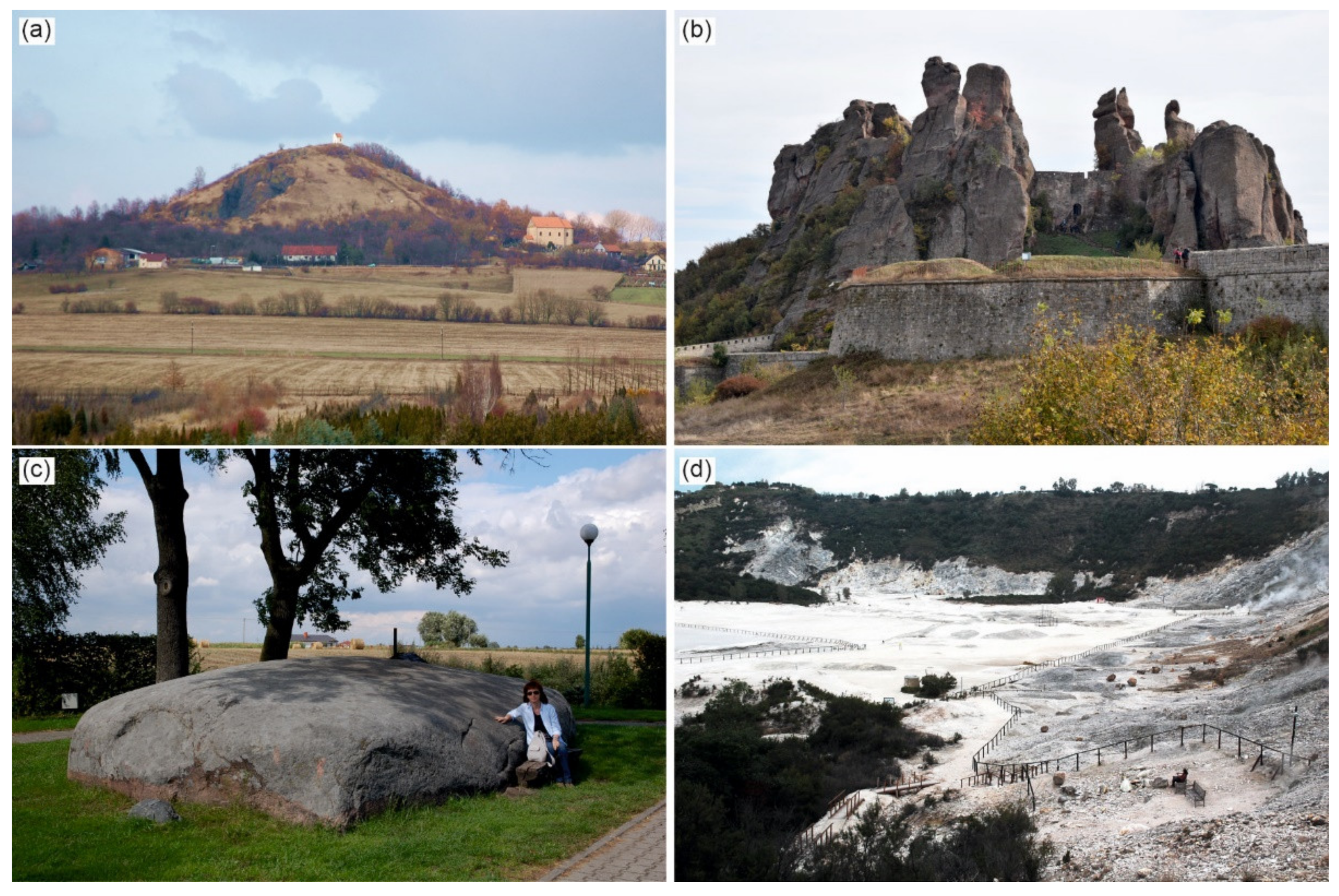
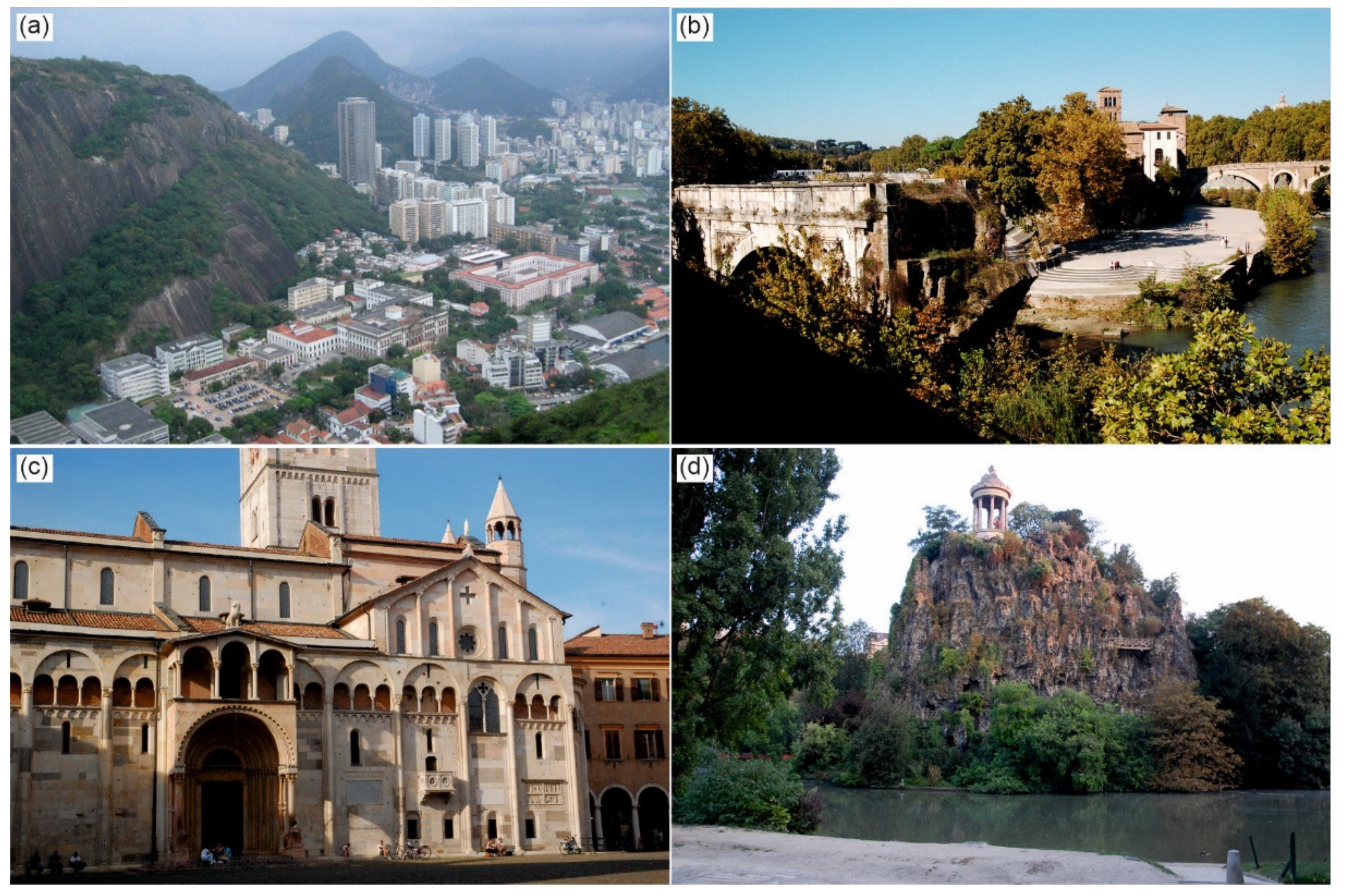
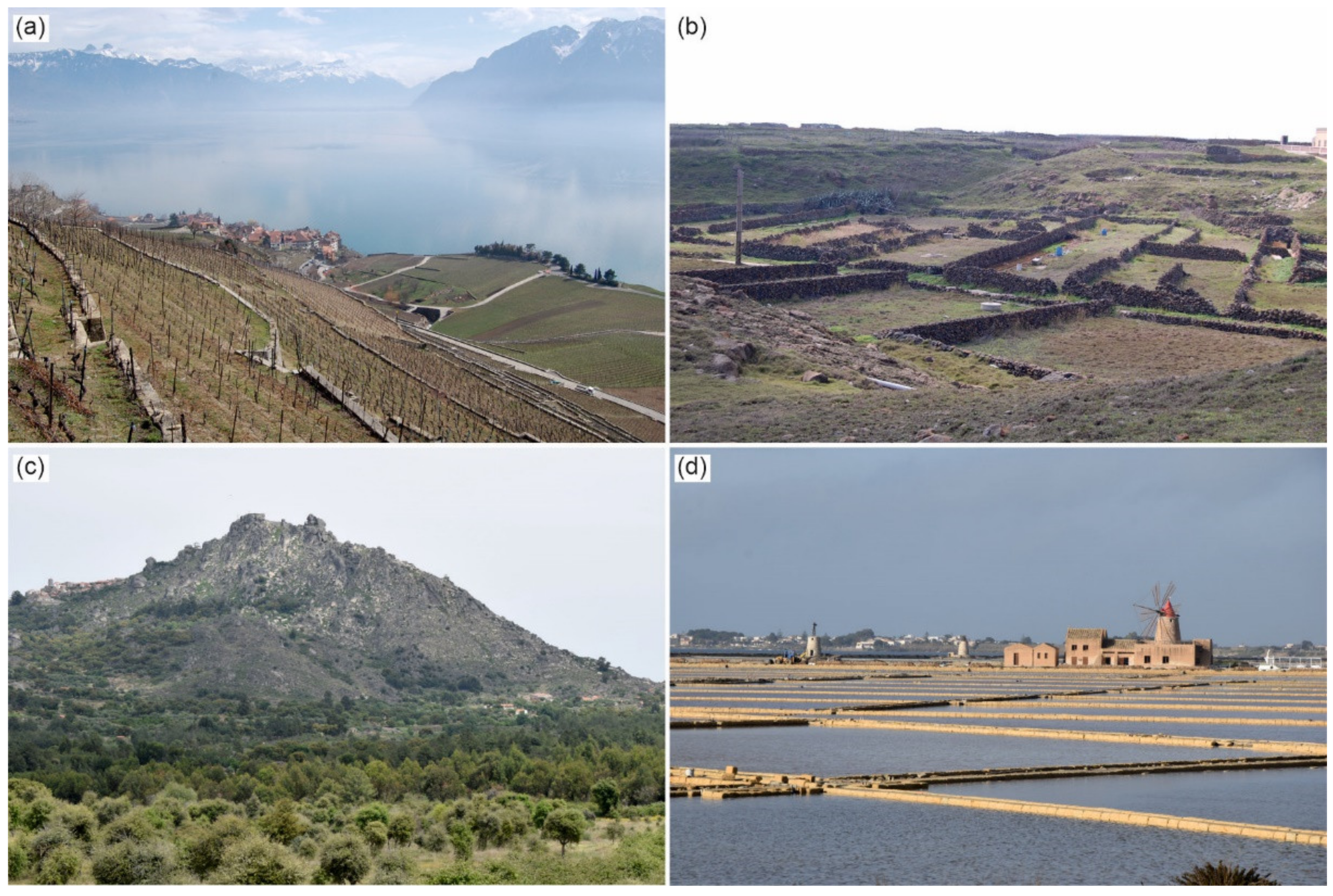
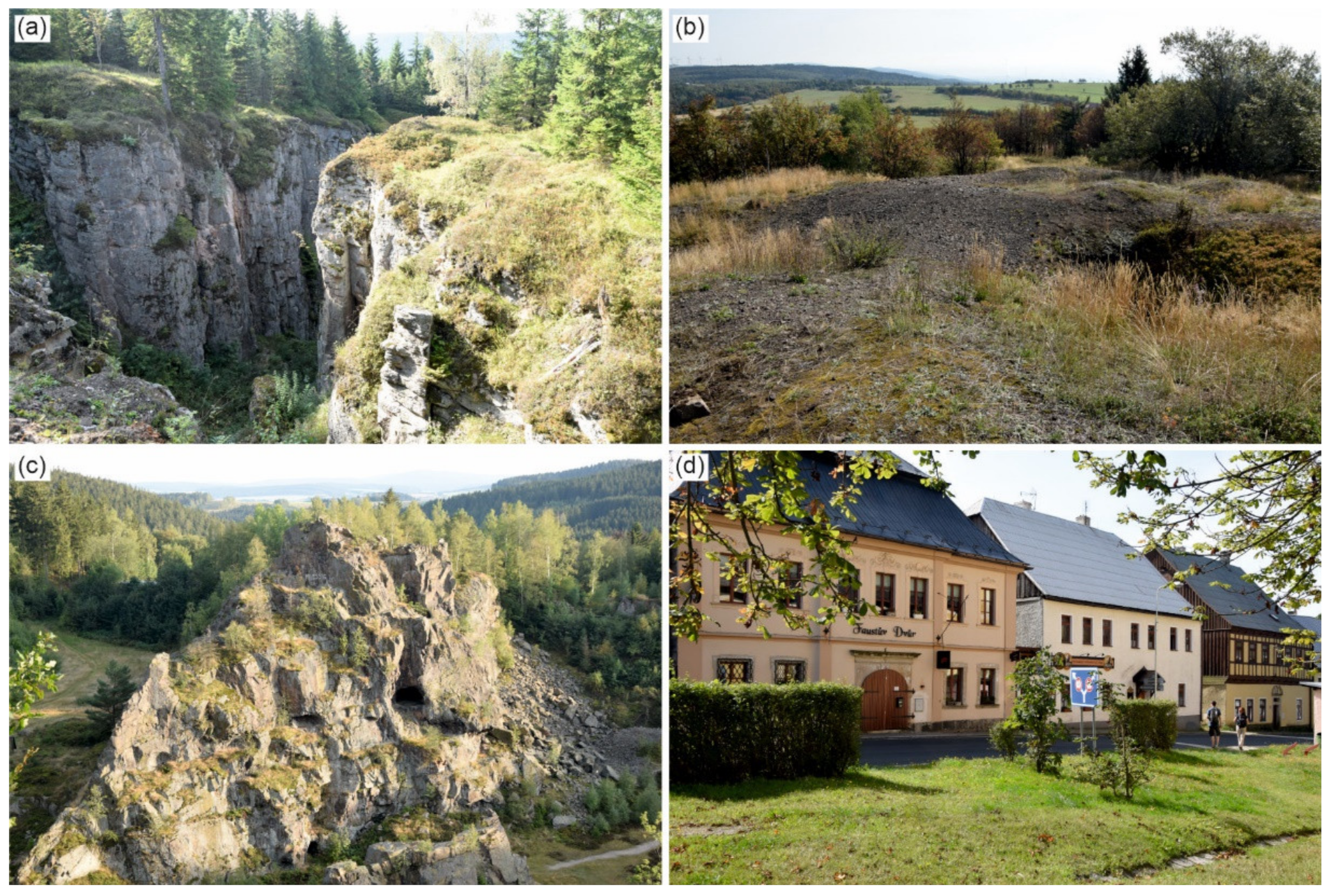
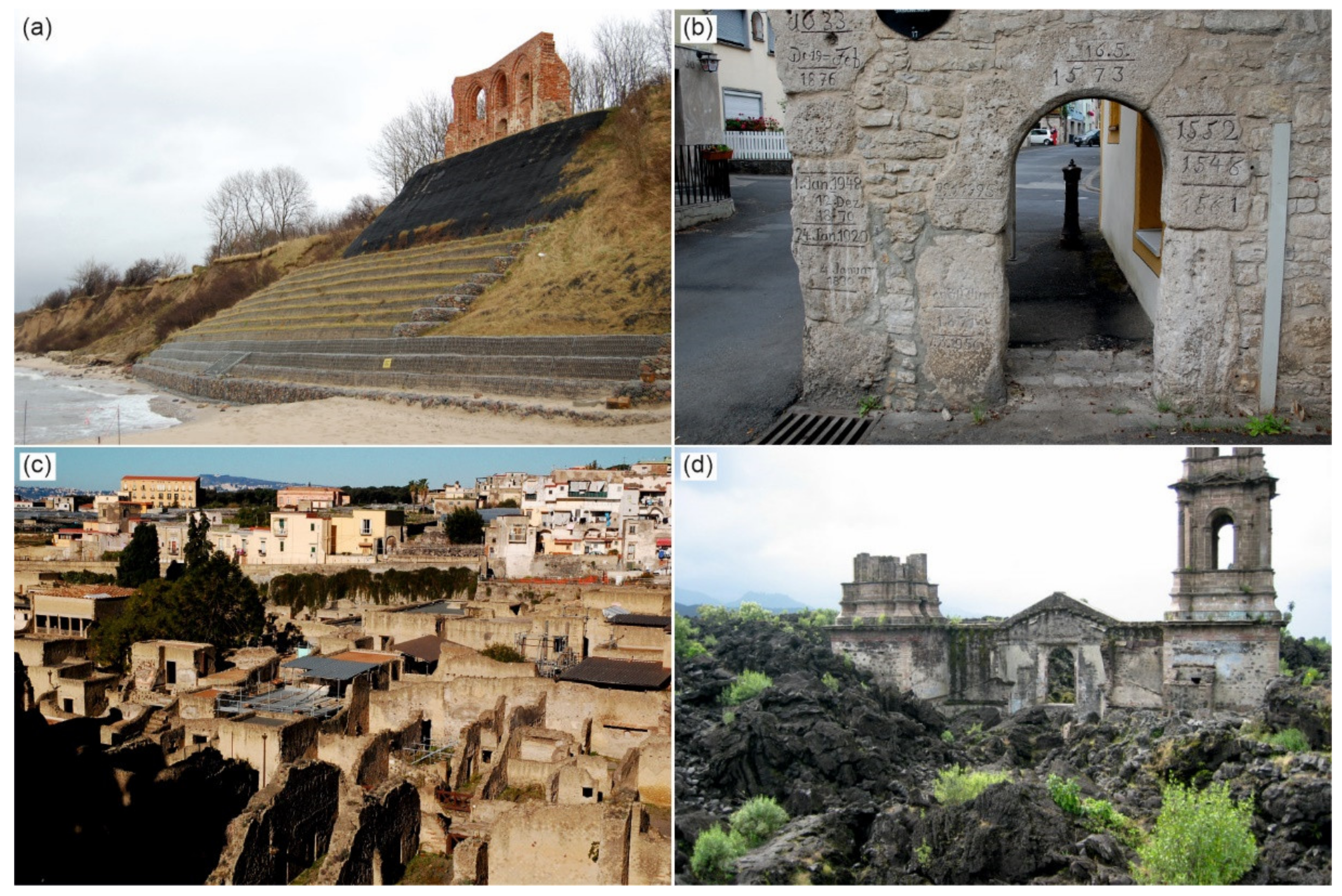
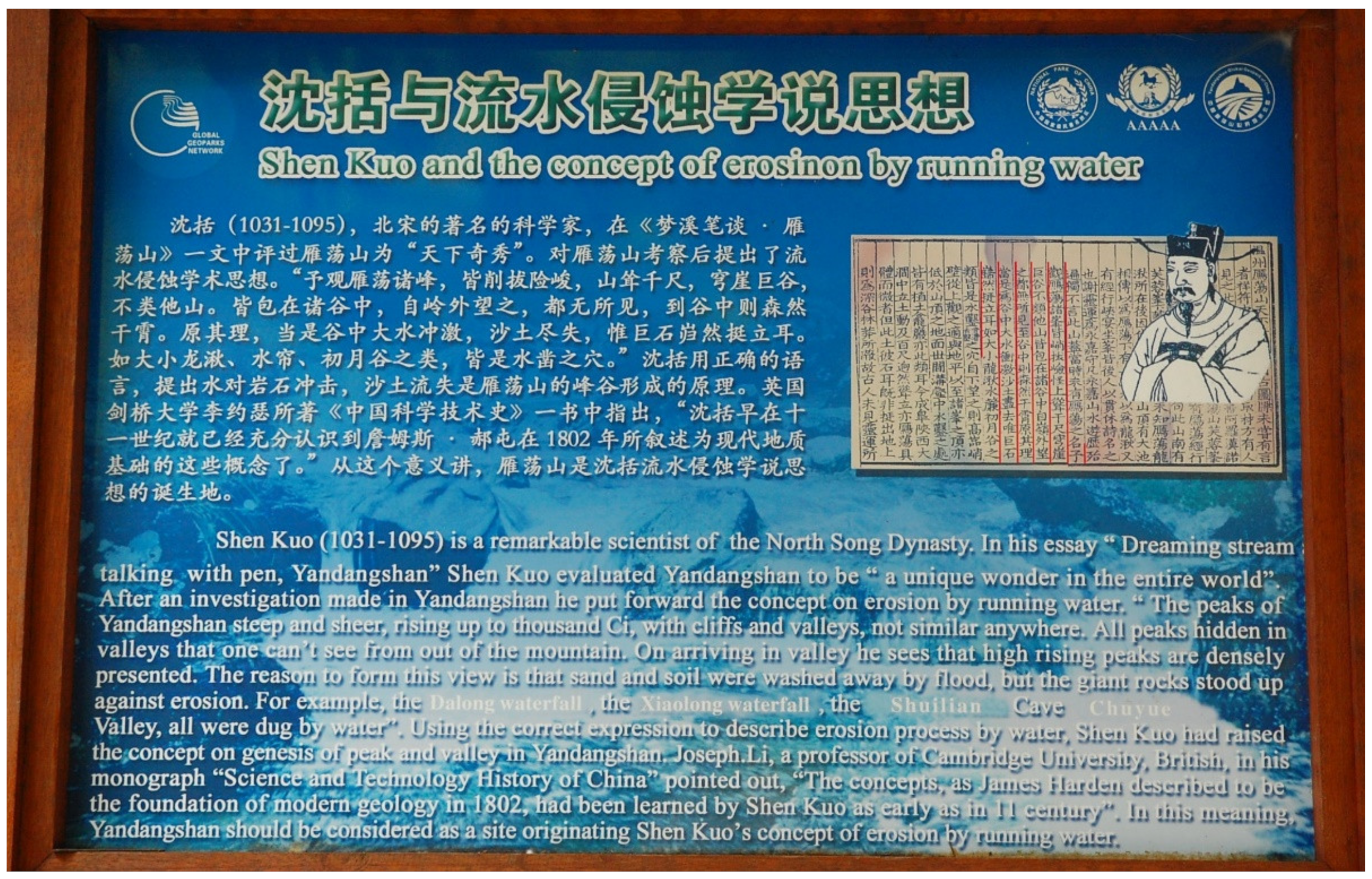
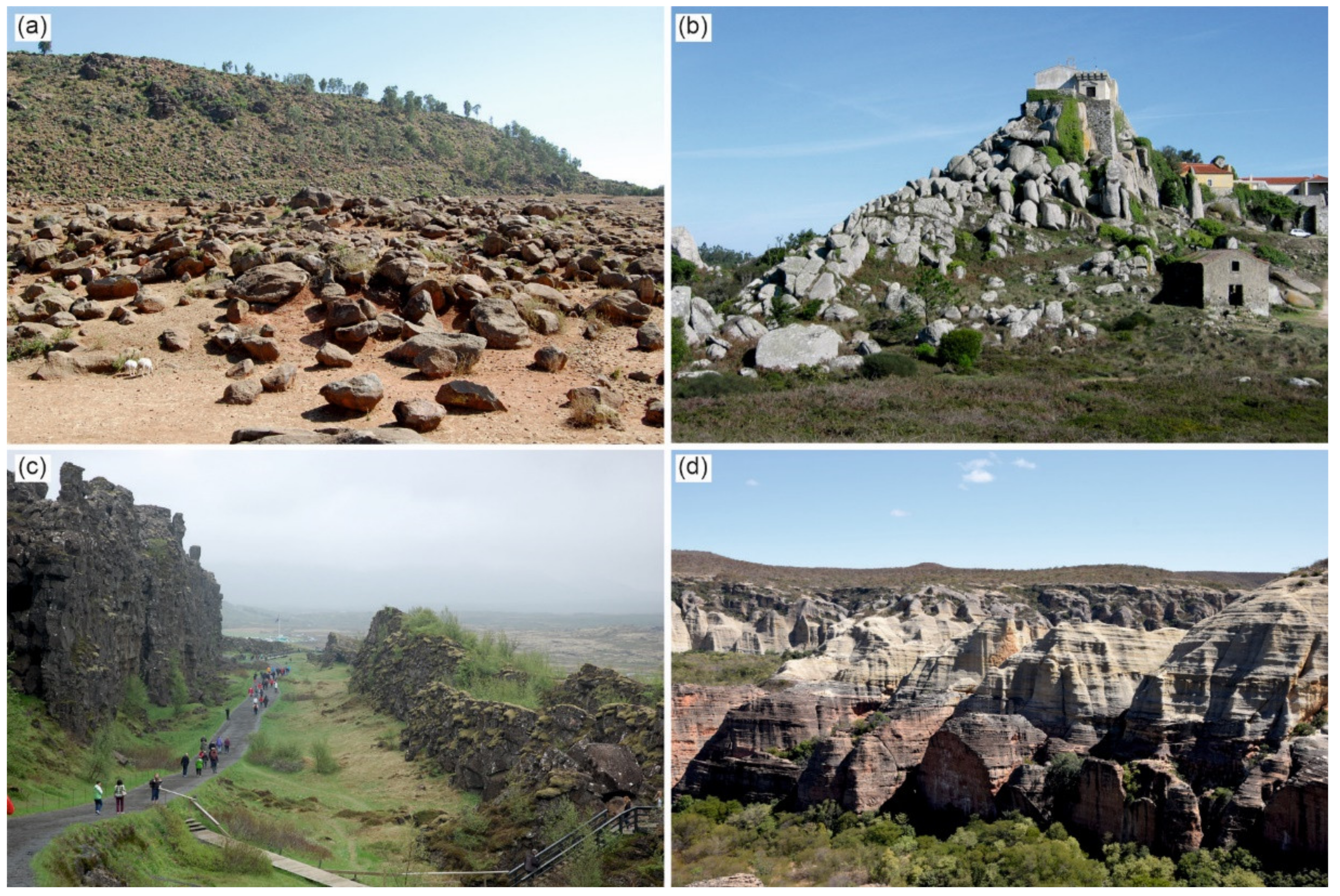
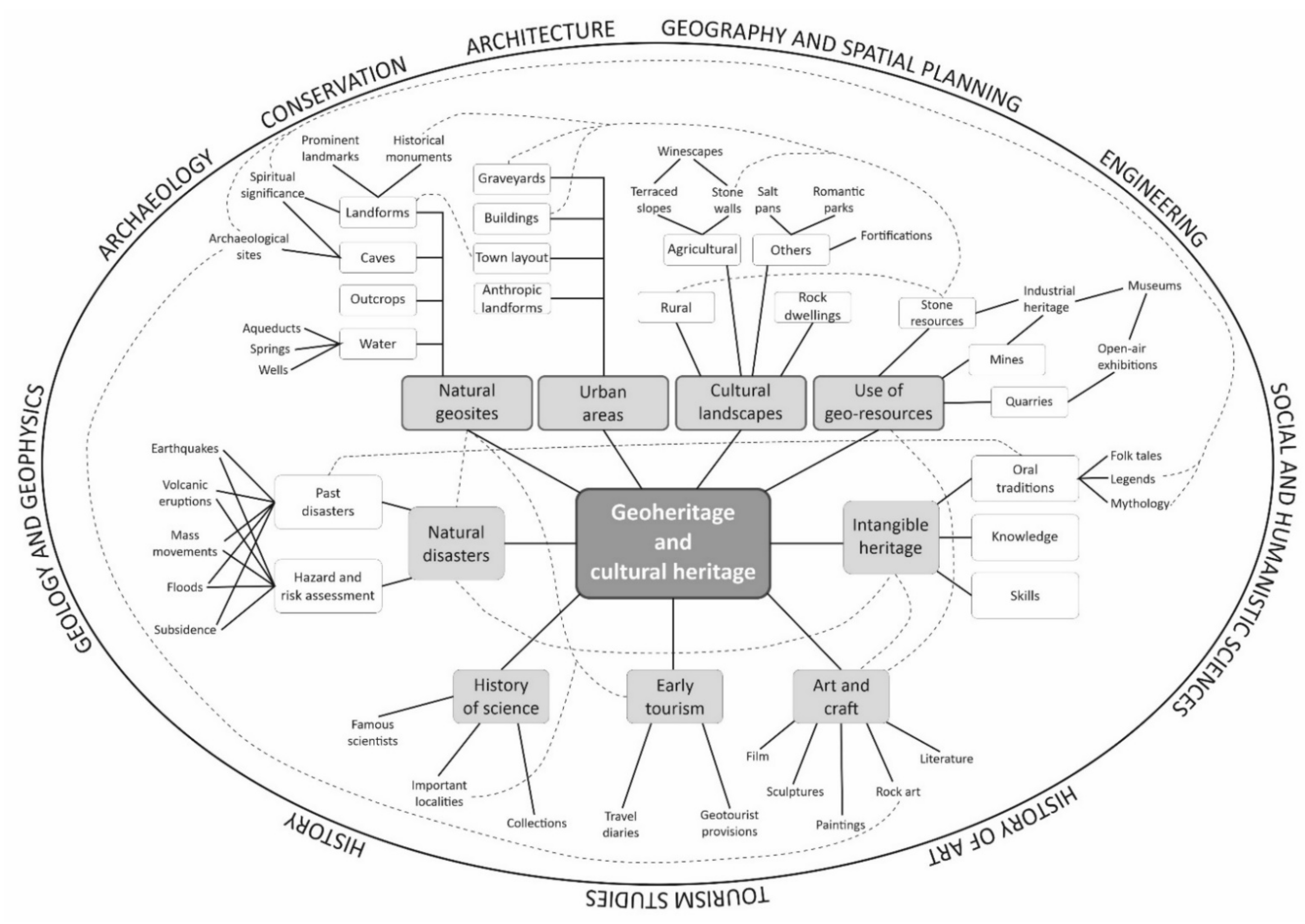
| A | B | C | D | E | F | G |
|---|---|---|---|---|---|---|
| Type of geoheritage | Type of human activity | Spatial scale | Temporal scale | Nature of evidence | Core values | Principal context |
| Rocks/stones/ minerals Fossils Geological structures Landforms Landscapes Springs and other hydrological phenomena Soils | Building construction Farming Mining, quarrying and industrial architecture Tourism and travel Science and education Art Craft | Cultural landscape Urban (town, city) Rural (village) Individual site/object Subterranean sites | Prehistory Antiquity Medieval Modern era | Tangible
| Geoheritage as core value Geoheritage as additional value Equal standing | Geo-conservation Geotourism Geo-educationRaising awareness |
Publisher’s Note: MDPI stays neutral with regard to jurisdictional claims in published maps and institutional affiliations. |
© 2022 by the authors. Licensee MDPI, Basel, Switzerland. This article is an open access article distributed under the terms and conditions of the Creative Commons Attribution (CC BY) license (https://creativecommons.org/licenses/by/4.0/).
Share and Cite
Pijet-Migoń, E.; Migoń, P. Geoheritage and Cultural Heritage—A Review of Recurrent and Interlinked Themes. Geosciences 2022, 12, 98. https://doi.org/10.3390/geosciences12020098
Pijet-Migoń E, Migoń P. Geoheritage and Cultural Heritage—A Review of Recurrent and Interlinked Themes. Geosciences. 2022; 12(2):98. https://doi.org/10.3390/geosciences12020098
Chicago/Turabian StylePijet-Migoń, Edyta, and Piotr Migoń. 2022. "Geoheritage and Cultural Heritage—A Review of Recurrent and Interlinked Themes" Geosciences 12, no. 2: 98. https://doi.org/10.3390/geosciences12020098






